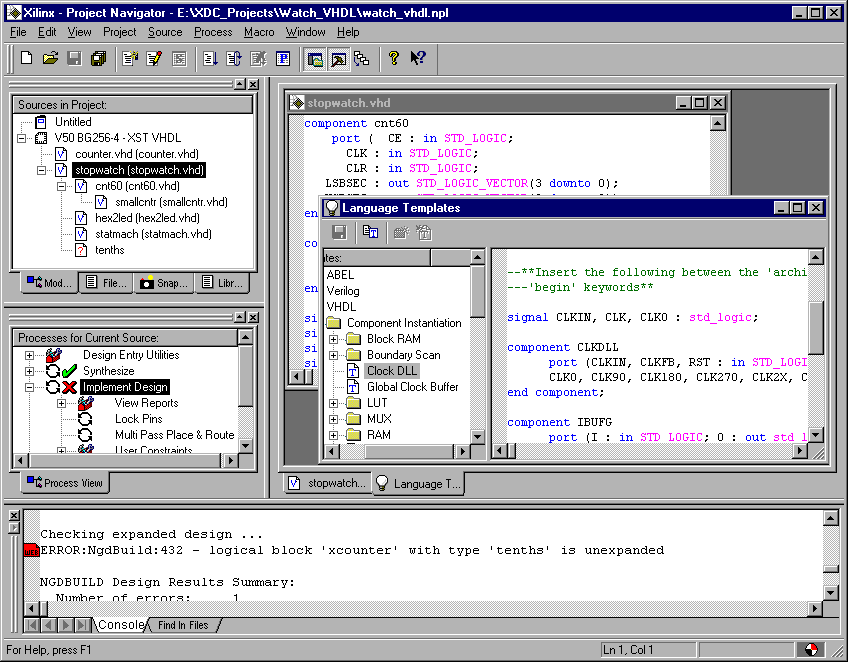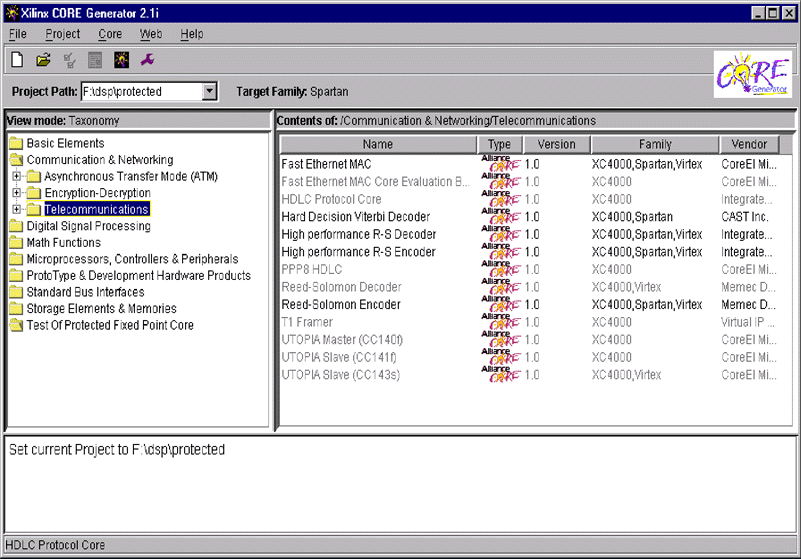
Introduction
to High-Density Programmable Design
By Lee Hansen and Anil
Telikepalli, EEdesign
Feb 6, 2001 (9:43 AM)
URL: http://www.eedesign.com/story/OEG20010206S0032
Part 2 of
4
By Lee Hansen, Xilinx Software Product Marketing Manager and Anil
Telikepalli, Xilinx Senior Technical Marketing Engineer
In Review
In Part 1 of this four-part series on high-density
programmable logic design, we focused on partitioning the overall design and
getting prepared for design entry. Using Xilinx High-Level Floorplanner we have
a high-density device partitioned into manageable modules based on entry method
and keeping timing concerns and signal traffic to a minimum. Coupled with Xilinx
Modular Design each module can be designed and implemented independently,
delivering device completion in faster. In this article we?l explore design
entry and management and the various methods available to quick and accurate
design creation. Most important, we'll explore the exploding use of intellectual
property, or IP, as a design solution.
Design Creation
The most common method of design creation today is
either VHDL or Verilog language text entry through a standard text editor, or
the now widespread use of context-sensitive language editors and LEDATM
verification. These editors can complete language statements through simple
keystrokes, analyze syntax for missing language structures, and in general
provide a very good editing environment. Xilinx Project Navigator (Figure 1),
where the engineer drives design entry, contains a complete VHDL/Verilog
language-editing environment, with context-sensitive help, and language
templates to help the user create code fast.
 Figure 1 -
Xilinx Proj Figure 1 -
Xilinx Proj
The use of schematic entry for design module creation is rapidly waning for
high-density design work. The amount of effort required during schematic entry
is just too intensive and time-consuming and too prone to error. But especially
at the top level of the design, schematic entry is still a quick and easy way to
place small amounts of necessary glue logic. Graphic entry as a design method is
experiencing a resurgence in high-density design. In the late 1980s graphic
entry became a popular design method, but as device density grew it proved to be
too cumbersome. Coupled with the use of Xilinx Modular Design, graphic entry is
making a strong comeback as design work concentrates on implementation of
smaller modules, not the overall device. With Xilinx's recent purchase of Visual
Software Solutions, StateCAD and HDL Bencher are now being tightly integrated
into the Xilinx standard design tools. StateCAD offers state-diagram, finite
state machine, truth table, and flow-chart logic entry that can then be output
as VHDL or Verilog code. These graphic-entry methods offer very good
documentation style in a very readable and easily understood format, and are the
preferred method of entry for a growing number of design engineers, depending on
the size of the target module.
The Focus on IP
The fastest growing design option of choice for
high-density device work is by far IP. This includes free or purchased
off-the-shelf cores and reuse of internally captured and verified code. The
manager staring down a project completion deadline is looking for quick,
accurate, affordable answers that can be tuned to a given use. The very nature
of the FPGA device fabric allows IP to enable quick product turnaround in a
reliable, repeatable format. Programmable IP core has already been verified
against the device family, eliminating the need for silicon verification and
thus reducing overall design time. Add to that the large-scale availability of
fully verified complex cores, and the design manager now has a wide variety of
design solutions at hand. This frees team members to concentrate on other
critical design areas toward completion. Using IP in high-density FPGAs is not
accomplished just with cores targeted at different applications, though how can
those solutions best be delivered to the design? Xilinx CORE Generator (Figure
2) is provided as part of the standard Xilinx software tool suite, and is linked
with regular core updates available via the Xilinx IP Center. Cores are offered
to the designer in a library interface. The designer can choose the parameters
to customize the core and make the area-speed trade-offs for that specific
design.
 Figure 2 -
Xilinx core generator Figure 2 -
Xilinx core generator
IP Internet Capture is integrated into Core Generator to facilitate design
reuse. Customers can capture their corporate-developed IP as standardized cores
and use the CORE Generator as a cataloging and delivery vehicle. Customer cores
then appear in the library interface for later selection and use. Through the
LogiCore program, Xilinx offers hundreds of standard IP functions. These include
cores such as multipliers, filters, FIFOs, error correction, Ethernet MACs, ATM
functions, HDLC controllers and video blocks among many others. The AllianceCORE
program expands this offering to include some of the best third party IP
available. And the Reference Design program offers free advice and design
applications from certified design centers throughout the world. Xilinx has
wrapped this information together at the Xilinx IP Center
(www.xilinx.com/ipcenter) containing everything you need to design with IP.
High-Density Applications
Dropping in a core to solve a critical
function is great, but only a part of the overall solution. As devices migrate
to higher densities a key function that FPGAs perform on the board is as
connectivity vehicles, interfacing the internal custom logic implemented in the
FPGA to external systems such as memories, network fabric, PC peripherals and
other ASSPs, and in this arena programmable IP serves a vital function. To meet
their needs, engineers use PCI, PCI-X, Rapid IO, POS-PHY, Flexbus, SDRAM
controllers, Utopia and other high-performance cores. Your designers don? need
to spend time recreating common interface functions, or worry about spending
time translating bus logic. For DSP design work, FPGAs offer superior DSP
processing power compared to any mainstream digital signal processor. Xilinx has
launched the XtremeDSP initiative to facilitate the efficient use of
programmable logic for system designers. Cores such as advanced DSP filters,
Reed-Solomon filters, modulators, transforms, math building blocks, video and
imaging algorithms and wireless cores are all available today. And through
XtremeDSP, Mathworks and Xilinx provide seamlessly integrated MATLAB/Simulink
and System Generator software, bridging the gap between the system design domain
and direct implementation in the FPGA.
Design Management
While we're now able to choose from several
diverse design methods, management of the creation process is a critical piece
to smooth completion. Xilinx Project Navigator (Figure 1) is also an intelligent
design manager making design entry and implementation much easier to deal with.
Project Navigator launches the correct tool for a given process and tracks that
module during creation and through implementation. Context-sensitive flows are
available as pushbutton processes to correctly implement a module. The user can
easily see what processes are completed or next in line to execute. Snapshots
can be taken to enable revision control of the design and can then easily be
restored at any point, leaving the engineer to pursue different design ideas and
abandon them if need be. Feedback along the bottom window is Web-enabled so that
error messages can be passed to the Xilinx Solution Center where solutions are
kept constantly up to date, giving the most direct and accurate answers to the
engineer, eliminating the time spent browsing through help files and
documentation to find the correct answer.
Coming Up
We've looked at planning and managing the overall
device, now we've looked at how to implement the design on a module-by-module
basis. We're coming to where the rubber meets the road; next time we'll look at
synthesis and verification. Go to http://www.xilinx.com/ for more information on
the products mentioned here including the Xilinx IP Center.
Copyright 2002 © CMP
Media, LLC
|
![]()